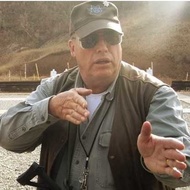30 May 19
The most difficult skill we teach!
My colleagues and I struggle daily as we energetically articulate fundamental principles of our Art, from personal philosophy to selection of critical equipment.
Most agree that the chief among challenging concepts we do our best to explain to our anxious students is the correct way to manipulate a trigger, as sight/reticle alignment is maintained.
We use colorful terms like:
“Surprise break”
“Stabbing”
“Watching your front sight”
“‘Jerking’ the trigger”
“‘Forcing/fighting with’ the trigger”
“Bayonetting”
“‘Milking’ or “heeling” the grip”
“Straight, flat, back”
“‘Anticipating’ discharge/recoil”
“‘Riding’ (exaggerating) recoil”
in a (sometimes vain) attempt to communicate to students the criticality of maintaining sight/reticle alignment with the target, as the trigger is simultaneously, smoothly pressed directly to the rear, all the way through discharge, then catching the link immediately after discharge as sight/reticle alignment is re-established in preparation for/anticipation of the next shot.
Absent adequate/detailed explanation, the forgoing terms, while commonly used, are confusing, meaningless, and unhelpful!
Happily, there are several devices I employ and have found useful in accelerating the process of the student’s understanding important maxims of trigger manipulation.
While I don’t “endorse” products, nor services, I’m happy to recommend those I like and find applicatory and useful.
Here are three:
Shotkam
Coolfire
Mantis
“Shotkam” is a video camera that attaches to a pistol’s rail. I records the shooter’s aiming point through discharge.
When the student is subsequently able to review the video, slowed-down to frame-by-frame, muzzle movement microseconds prior to discharge becomes visible and obvious!
This visual exposure provides a way for the student to actually see what he is doing, and what is happening as he presses the trigger.
Merely describing the phenomenon is often confusing to the student, but actually seeing it is convicting!
“Coolfire” attaches to a functional pistol and, via compressed gas, simulates normal recoil.
I find Coolfire enormously useful in getting students past their fear of recoil. They can experience normal recoil associated with discharge (absent the noise) thousands of times without having to be on a range, all at fractions of a penny per “shot.”
While there is, of course, no substitute for live fire, Coolfire goes a long way in preparing students to hold steady through recoil, catch the link, and then resume firing- all before going to the range and experiencing the real thing.
The Mantis System consists of a small rail attachment that goes on pistols. It contains an electronic gyroscope that faithfully records the slightest movements, and then subsequently displays the entire episode graphically, including normal “drift” or “wobble” associated with the shooter’s sincere attempt to hold sights “steady.”
Like the Shotkam System, Mantis makes plainly visible to the student what we instructors find so difficult to describe verbally.
Using both Mantis and Shotkam, I’ve had many students say, “Oh! So that’s what I’m doing.”
This refreshing revelation, after frustrating hours of trying to explain in so many words what is happening.
All three of these training aids are highly recommended to serious instructors!
“The goal of the student and the instructor is always the same:
The improvement of the student.”
Anon
/John


